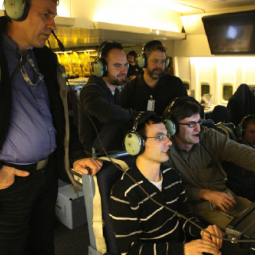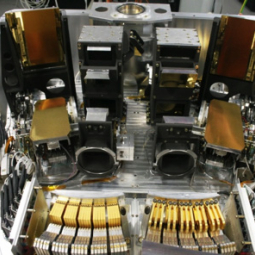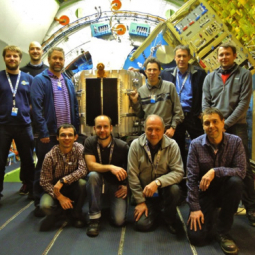The FIFI-LS (Field-Imaging Far-Infrared Line Spectrometer) instrument developed by the University of Stuttgart was carried aloft by SOFIA for its “first-light” flight on March 7, and subsequently completed its first series of commissioning flights. Right “out of the box”, the instrument displayed exceptional performance.
FIFI-LS principal investigator Alfred Krabbe (Institute of Space Systems, University of Stuttgart) was obviously pleased by the results of this eagerly awaited inaugural flight: “Our first target, VY Canis Majoris, popped up right in the middle of our field of view, which we celebrated with loud applause and a lot of very happy faces. We were able to focus the instrument and commence observations immediately.” Alfred Krabbe and his team of technicians, scientists and engineers had been working toward this moment at full capacity during the preceding month.
The complex instrument’s rotation axis was aligned with the telescope’s axis by observing point sources such as the planetoid Ceres, and the behavior of the image field-rotator was tested at its operational temperature of 77 K. During the next two flights, on March 10 and 12, Krabbe and his team also conducted sensitivity tests, flux calibrations, and wavelength calibrations.
The FIFI-LS team observed planetary nebula NGC 6543 (also known as the Cat’s Eye Nebula) for wavelength calibration by taking a series of images at a wavelength of 51.815 microns, corresponding to a prominent spectral line of doubly ionized oxygen [OIII]. This observation was the first time that spectral line could be observed by anyone since 1988 when the Infrared Space Observatory (ISO) ceased operations. The FIFI-LS map of the nebula’s center spatially resolved NGC 6543 for the first time in that spectral line. Astronomers will be able to derive the velocities and cooling mechanisms in the expanding nebula from the widths and shapes of spectral lines.
Within the next few weeks the FIFI-LS team will carefully analyze their test data, determining whether adjustments to optimize the instrument’s operation are necessary. The second series of commissioning flights will take place in mid-April, followed by FIFI-LS’s first official science observations for the astronomical community.
FIFI-LS is a so-called “3-Dimensional spectrometer” that obtains both imaging & spectroscopic data at wavelengths between 45 and 210 microns, making efficient use of SOFIA’s valuable observing time. These comprehensive data sets from FIFI-LS can allow astronomers to identify and understand complicated physical processes in the interstellar medium and star-forming regions in our Milky Way Galaxy and other nearby galaxies.
FIFI-LS was first mounted on the SOFIA telescope starting February 28. The installation was followed by two nights of extensive “line operations”, test observations made from the ground. The professional preparation of the FIF-LS/U. Stuttgart/IRS team evidently paid off: Randy Grashuis, mission director of the US SOFIA flight team said appreciatively, ”From my perspective this was the smoothest first night with a new scientific instrument that I've ever experienced on SOFIA."
Based on a German-language version by Dörte Mehlert posted at the DSI website .
SOFIA is a joint project of NASA and the German Aerospace Center (DLR). The aircraft is based at NASA Armstrong Flight Research Center that manages the program. NASA Ames Research Center at Moffett Field, Calif., manages the SOFIA science and mission operations in cooperation with the Universities Space Research Association (USRA) headquartered in Columbia, Md., and the German SOFIA Institute (DSI) at the University of Stuttgart.
Points of Contact
Dana Backman
SOFIA Outreach
NASA Ames Research Center
Moffett Field, CA 94035-0001
650-604-2128
dbackman@sofia.usra.edu




